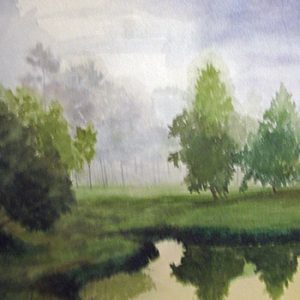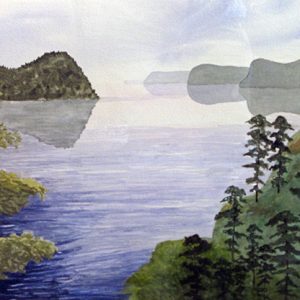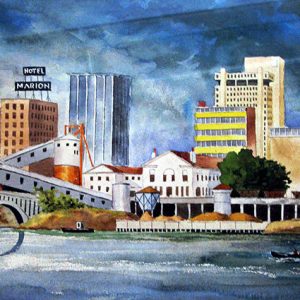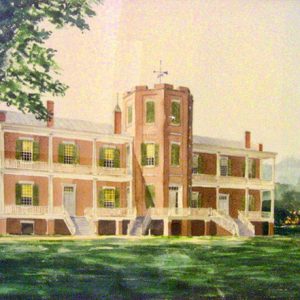calsfoundation@cals.org
Bruce Roy Anderson (1907–1985)
Bruce Roy Anderson was a prominent Arkansas architect and watercolorist in the mid-twentieth century.
Bruce Anderson was born on October 7, 1907, in Newport (Jackson County), the son of George Roy Anderson and Amelia Frei Anderson. He had an older brother, Maxwell, and sister, Bernice. Anderson attended Little Rock (Pulaski County) public schools and graduated from Castle Heights Military Academy in Tennessee. He received a bachelor’s degree in architecture from Auburn University in Alabama in 1929. In 1936, Anderson earned a Master of Architecture degree from the Graduate School of Design at Harvard University in Cambridge, Massachusetts.
Anderson married Helen Venus McClain on December 25, 1931. They had one son, Bruce R. Anderson Jr.
Anderson began his architectural career in 1929 as a draftsman for Wittenberg & Delony Architects in Little Rock. Prior to the outbreak of World War II, he was a partner in the McAninch and Anderson architectural firm.
During World War II, Anderson was stationed at the U.S. Army military facility in Pine Bluff (Jefferson County). He attained the rank of captain. In 1942, Anderson worked with Allied Architects of Memphis, Tennessee, in planning the Naval Reserve Air Base and hospital in Millington, Tennessee.
After Anderson’s honorable discharge in 1946, he and a good friend, H. Ray Burks, formed the Burks and Anderson architectural firm. Their firm obtained the commission to design War Memorial Stadium in Little Rock. In 1948, following Burks’s unexpected death, Anderson founded the Bruce R Anderson architectural firm in Little Rock.
During Anderson’s long architectural career, he designed many Arkansas churches, schools, commercial buildings, and hospitals. Anderson was a primary architect for the University of Central Arkansas (UCA) in Conway (Faulkner County), Harding University in Searcy (White County), and Ouachita Baptist University (OBU) in Arkadelphia (Clark County). In 2013, Anderson’s W. C. Ferguson Memorial Chapel, built in the shape of a Greek Orthodox cross on the UCA campus, was added to the National Register of Historic Places.
Anderson was the architect for a major restoration of Arkansas’s Old State House in Little Rock. During the renovation, Anderson discovered many long forgotten architectural aspects of the original structure, such as its immense beams of native virgin pine and cypress, the quarried native stone foundation joined together with mortar, and the two-foot-thick red brick exterior walls covered with a heavy stucco. Prior to Anderson’s involvement, little was documented or known of the architectural aspects of the historic structure.
After the age of fifty, Anderson began to develop his interest in painting watercolors. Anderson was essentially a self-taught artist, but much of his technique was developed while in architectural school, where he studied watercolor, charcoal, and pen-and-ink drawing. Adrian Brewer, the well-known Arkansas artist and teacher, and George Post, the noted Californian watercolorist, were among Anderson’s instructors. Anderson also took painting classes at the Arkansas Arts Center (now the Arkansas Museum of Fine Arts).
Anderson is perhaps best remembered for fourteen paintings of Little Rock’s historic Quapaw Quarter buildings, including the Villa Marre, the Little Rock Arsenal in MacArthur Park, Trapnall Hall, and the Capital Hotel. He served on the board of the Quapaw Quarter Association. An illustrated publication of the Arkansas Chapter of the American Institute of Architects said that Anderson’s paintings were easily identified “because they developed from architectural renderings portraying a realistic graphic of the subject. His technique is delicate yet vivid, detailed yet not overdone.”
In 1968, Anderson’s watercolor Low Rent was accepted in the Cooperstown, New York, Art Association’s thirty-third annual exhibition. The painting depicted a multiplex structure of low-cost housing cast in deep shadows. Top prize at the exhibition that year was awarded to Norman Rockwell, the American painter and illustrator, but Anderson’s entry won recognition and drew attention from the French art magazine La Revue Moderne des Arts published in Paris and distributed throughout Europe. The following year, Low Rent was used as the magazine’s cover illustration. Another Anderson painting of the Pike-Fletcher-Terry Mansion (now the Terry House Community Gallery) appeared in the magazine.
In 1970, Anderson, along with four other artists, founded and incorporated the Mid-Southern Watercolorists (MSW) in Little Rock. Anderson was elected as the organization’s president in 1973.
Anderson exhibited his watercolors in one-man shows and won numerous awards in Arkansas, New York, Massachusetts, California, Tennessee, Texas, Florida, and Louisiana. In 1969, Anderson’s painting Ouachita Mountains was selected best of the show at the Arkansas State Festival of the Arts. It was the twelfth consecutive award-winning year at the festival for Anderson; a record unmatched by any other artist. In 1976, his watercolor Plantation Lullaby won the Governor’s Award at the fourth annual Arkansas Arts, Crafts, and Design Fair.
Anderson was a member of the National Watercolor Society, Mid-Southern Watercolorists, Southwestern Watercolor Society, California Watercolor Association, Arkansas Arts Center, American Institute of Architects, and Guild of Religious Architects. He served on the board of the Arkansas Festival of the Arts. He was a founding member of Pleasant Valley Country Club in Little Rock and the Arkansas Children’s Hospital Board of Trustees.
Anderson’s art can be found in many private collections and in the collections of the Central Arkansas Library System‘s Butler Center for Arkansas Studies in Little Rock.
Anderson died on April 4, 1985, in Little Rock and is buried at Roselawn Memorial Park.
For additional information:
“Architect-Artist Bruce Anderson Started Painting Gourds and the Project Grew.” Arkansas Gazette, September 6, 1970, p. 6D.
“The Architect as an Artist, the Artist as an Architect.” DIMENSIONS: The Official Publication of the Arkansas Chapter, American Institute of Architects (May/June 1969).
“Bruce Anderson, Architect, Watercolor Artist, 77, Dies.” Arkansas Democrat, April 5, 1985, p. 10B.
“French Print 2 Paintings by Arkansan.” Arkansas Gazette, December 10, 1969, p. 28A.
Mid-Southern Watercolorists Collection. University of Central Arkansas Archives and Special Collections, Conway, Arkansas.
Thomas A. Teeter
Little Rock, Arkansas
 Beside Still Waters
Beside Still Waters  Broken Bow Lake
Broken Bow Lake  Little Rock Skyline
Little Rock Skyline  Old Arsenal
Old Arsenal 




Comments
No comments on this entry yet.